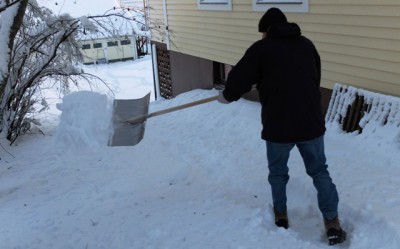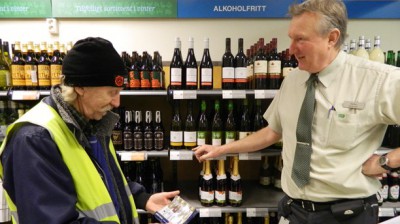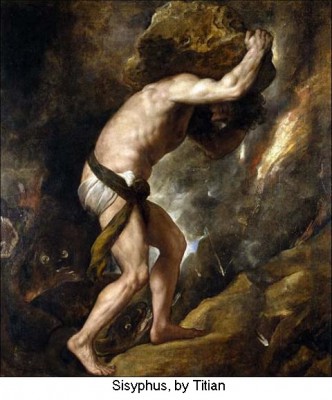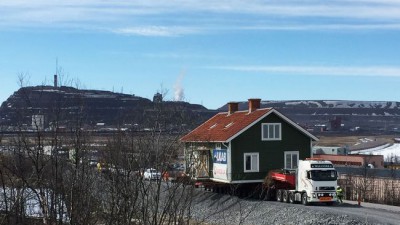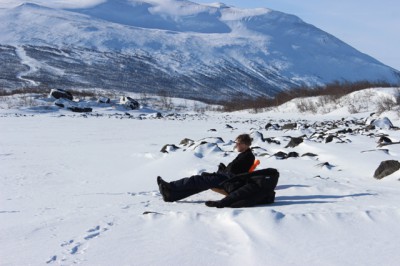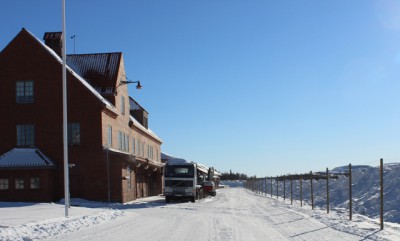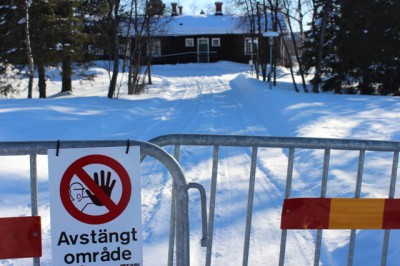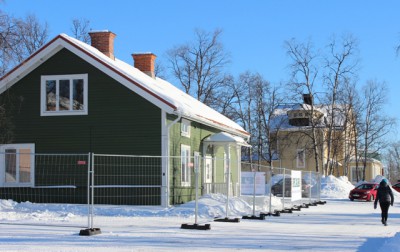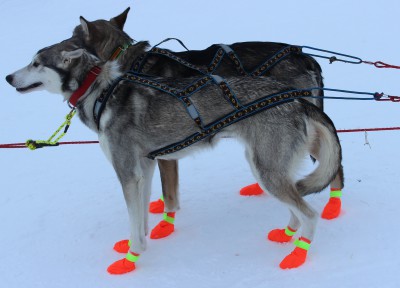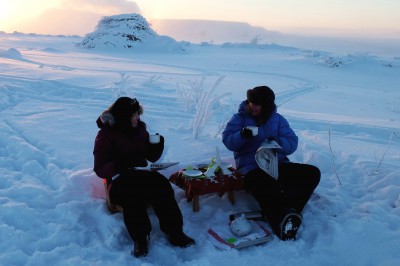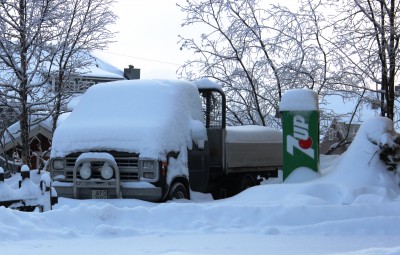Last night I took out my crystal ball. I wasn’t sure it was still working, but I gave it a good scrub and then a billowing mist spread around the ball. I waited patiently for the mist to clear.
I was wondering what the future holds for the town of Kiruna. That it will slowly disappear into a mining pit is not in doubt, but what will emerge in its place is the question.
Over the last few years, since we all knew the town would have to move, we’ve listened to all kinds of consultants brought in by the local council to ‘have ideas’ on our behalf. It hasn’t been easy. There was the ‘Kiruna 4 ever’ phase for instance, when I felt like we were back in primary school, playing with our crayons to draw our way out of the problem. That wasn’t far from the truth – the local council did ask local schoolchildren to come up with some ideas. These, as it turned out, were a lot more sensible than the ones the consultants came up with. Flying gondola transport, huge outdoor bubble pools, and a giant tropical greenhouse – it was hard to keep a grip on reality.
Architects from anywhere far enough way to have no experience at all of what it is like to live here – Norway, Denmark, the far south of Sweden (where is Malmö, exactly?) – were invited to take part in a competition by submitting a plan for the new town. In their architectural design plans we saw ourselves depicted, calmly chatting to one another in the new town square in minus 30 degrees, having arrived there from our nearby flats on our skis, warming our hands round the town (architect-designed) brazier. We were a people, apparently, ill-adapted to walking (hence the skis) but well adapted to temperature (hence the standing around getting cold chatting rather than diving into a nearby shop or cafe). We’ve known it was all a huge distraction, so we’ve been holding our collective breath, waiting for the mist to clear so we could see the real picture. We’ve gone red in the face now, it’s been so long.
The first thing that happened was that last year they started building the new town hall and laying the road infrastructure in the area to be the new town centre. I saw the pipes going into the roads today, the pipes to serve all the buildings that are expected to appear. Only, no-one seems to want to build there. The costs are too high, there’s nobody there, there’s no reason for anyone to move there so there’s no reason for anyone to invest money to build anything. There’s a rubbish tip right next to the site, and they haven’t even found a place to move it to.
Kiruna is hanging out with mates on one of the old street corners, whistling quietly to itself, looking in the other direction. It’s a bit embarrassing, all this new town centre lark.
Meanwhile LKAB (the mining company) is negotiating individually with flat owners, businesses and shops that will have to move. The rest of us are watching, nervously, and it’s more entertaining than ‘Melodifestivalen’ (selecting the Swedish entry for the Eurovision Song Contest). In this popular game show (called, ‘The Price is Right!’) contestants are given a choice: they can either choose replacement premises, in an empty undeveloped area where no-one else in town has moved yet, for an undisclosed rent (but definitely a lot higher than they currently pay); or they can choose a sum of money as compensation. It’s no surprise that every time the audience screams ‘Take the money! Take the money!’. And they do.
This, you may appreciate, isn’t helping the local council make their dreams of a new town come true. No-one is committing themselves to the new town, so builders and property management companies have no reassurance that if they build there anyone will actually choose to move there. You’d have thought the local council could have predicted this problem – and worked out a way of attracting people to committing themselves early on – but they don’t seem to have had a functioning crystal ball. Pity.
In their crystal ball they might also have seen the rival shopping and business area developing in another part of town. They might have seen the large rental units being built and the shops moving there and they might have realised, this needs to be stopped! These businesses have to be persuaded to move to the new town centre instead!
Too late! It’s already happened! The Coop Forum shopping area is ugly, functional, and full of people. Right next to it is Lombolo, Kiruna’s largest suburb – a quiet area of curving streets on the edge of town, now very well placed for access to the best place to shop. The Coop Forum area has a large food supermarket, electronic gadgets and equipment, high street fashion, building materials and pet supplies. Single retired men, who’ve spent their lives working for the mine, like to hang out in the burger bar for hours and watch the world go by. Someone sells lottery tickets for the local Lions Club in the main supermarket entrance. Youth hang around the car park looking cool. It even has street beggars. Sounds like a town centre? Well yes, but not the kind imagined by those clever architects, clearly – there’s no-one here languishing idly against a fancy brazier in a pair of skis – but to us, well, we think we could do worse.
From the Coop Forum car park we look nervously over our shoulder towards the ‘new town centre’, where snow blows aimlessly over ground that is not looking like it’s going to be a town or a shopping centre anytime soon.
Rubbing their crystal ball one more time, and this time looking in another direction entirely, the council might have seen something even more worrying and threatening. On the horizon, to the north west of town, on the slopes of Luossavaara, where LKAB have always wanted the new town to be (because there’s no iron ore there) there is building work going on. A lot of building work actually. This year, contrary to what was originally planned, some of Kiruna’s historic old buildings will be moved there. They had been planned for the new town in the early days, but something changed. So now, they will go far away to the other end of town. LKAB is responsible for them – it owns them – so it is moving them. LKAB is also building some fine new flats there. Many of their own tenants will be offered one of these flats, near the old town centre, with mountain views, in an area where people already live. It won’t be a difficult choice for people to make – a flat here, or a flat which may or may not be built next to the new town hall somewhere that is currently not part of a town.
I think the council have been rather negligent, not keeping their crystal ball in proper working order. They’ve had a lot of meetings, and paid an awful lot of consultants, but none of them it seems thought to consult a crystal ball. Pity.
I’m shaking mine rather fiercely now, trying to tune in to 20 years’ time. Eventually the haze disappears and out pops a clear picture.
It’s the new town centre – I know that because on my extra high-spec ball I get smells as well, and I get a whiff from the rubbish dump there – they obviously never found a place to move it to. Anyway, I can see some buildings – there stands the new town hall – it looks very nice and round – and nearby is a swimming pool and a sports centre. At more of a distance I can see a school. Along the road, in the old cemetery, stands an odd looking building – a sort of modern brick block with a tent shape on the top. It’s Kiruna’s church (I guess it turned out to be too difficult, after all, to move the old one). The streets are named, but there aren’t any buildings on them – just some cars parked, perhaps people coming here for a swim, to collect children from school, or maybe to pick a fight with a politician in the town hall. A local bus swings past, empty. No-one stands near the (architect-designed) brazier in the main town square. Street lamps shed light on piles of snow which hasn’t been cleared away – I suppose since no-one lives here there’s no real need. Still, the kids coming out of the swimming pool are having fun throwing themselves around in it, before getting back on the bus which takes them to the other side of town.
If I shake the ball again, and concentrate really hard I can follow the road away from the ‘town centre’ to the Coop Forum shopping centre. Yes, there it is, lots of large retail units and a full car park, and the nearby suburb of Lombolo has grown too.
The crystal ball picture fades, and then shows a strip of old streets and houses – we live here – connecting this area to the other side of town, like a bridge. On both sides of this street I can see mining activity. On one side is a huge pit, where the old town used to be, and on the other side is the new mine (Lappmalmen). Doesn’t look like these streets will last for very much longer.
This image is then replaced by another – streets in the north west part of town, the slopes of Luossavaara. It’s quite tightly packed here now – I see the old buildings that were moved here – there’s some of the old ‘inkpot’ style houses, and the mine’s original hotel building, and the home of the first director of the mine. Continuing on from the residential streets that used to be here there’s now a whole new area of flats and houses, shops, cafes and restaurants, clustered together in the small spaces available on either side of the new main road out of town. Above them the downhill ski slopes operates as before, and is now supplemented with cross country ski tracks and snow scooter tracks on either side.
At the bottom of Luossavaara stands the ‘temporary’ railway station, now a permanent one because it’s so useful for bringing people to Luossavaara. ‘Welcome to the town of three parts’, says a sign outside.
I think I’ll have to lend my crystal ball to the local council, if it’s not already too late.
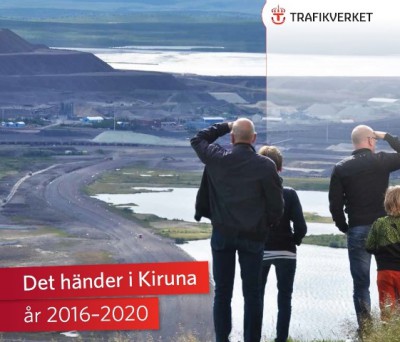
Trafikverket is responsible for building Kiruna’s new main road. Their leaflet – ‘It’s happening in Kiruna’ – seems to show people confused about where exactly the town is.
See my previous entry, ‘Looking for the lentils’, 2015:
http://www.blog.68degrees.se/#post120
